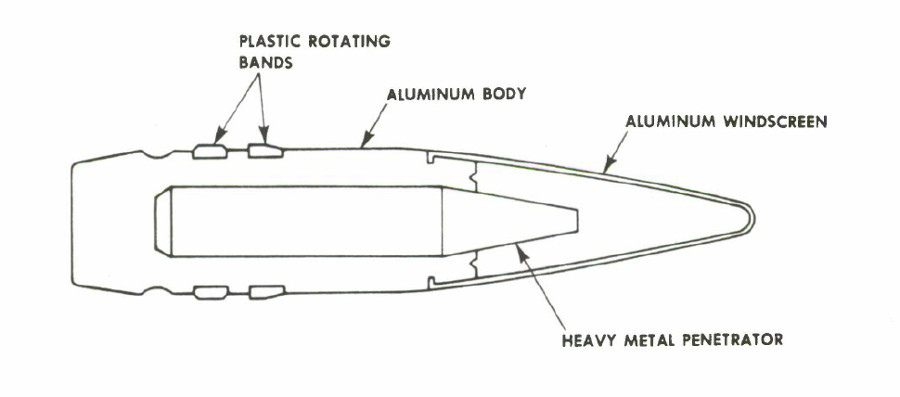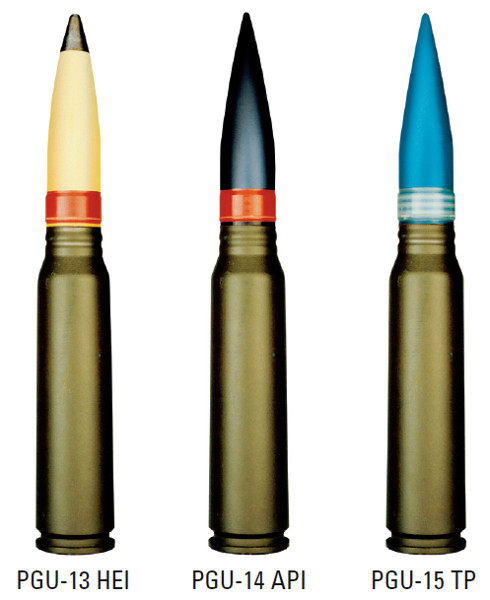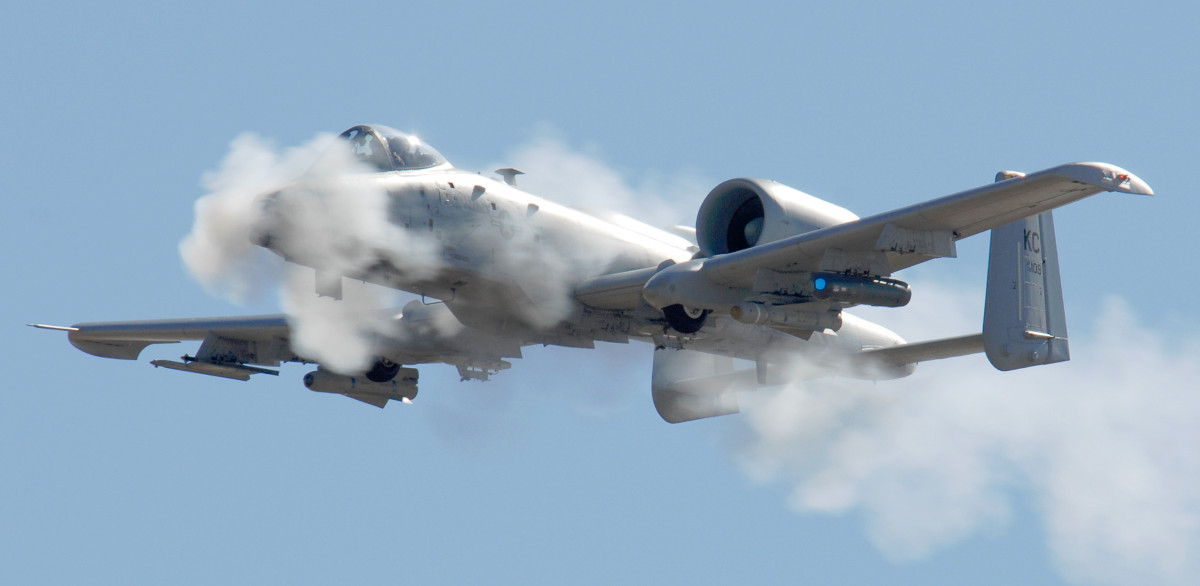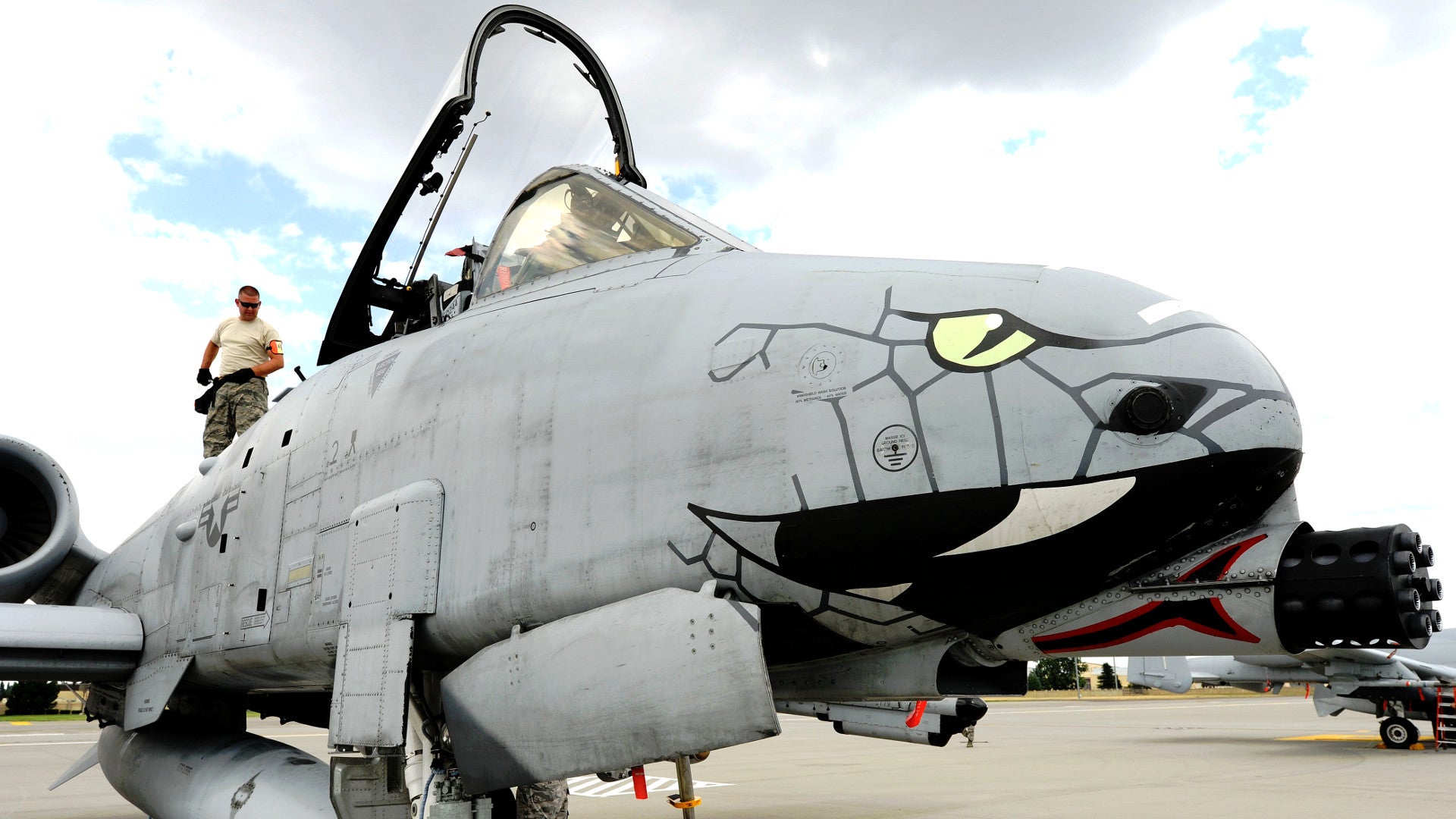The U.S. Air Force is looking to get new ammunition for the A-10 Warthog’s iconic GAU-8/A Avenger cannon and is debating whether it should buy rounds with armor-piercing cores that don’t contain controversial depleted uranium. Amid a shift in focus across the U.S. military toward preparing for high-end conflicts
against conventional adversaries, the service needs to replace its stockpiles of the existing tank-busting shells as they are reaching the end of their shelf lives.
Military.com was first to report on the possible change in the shell’s construction. The simplest alternative available to the Air Force would be to replace the depleted uranium in the armor-piercing cartridges, known as the PGU-14/B, with another dense metal, such as tungsten. The DU shell is one of two primary combat rounds for the A-10s, the other being the PGU-13/B high-explosive incendiary type. The two are commonly mixed together in the aircraft’s magazine at a ratio of five armor-piercing rounds to every high-explosive one.
“There’s a lot of discussion of whether we’re going to use depleted uranium again, or the tungsten penetrator,” Bob DuPont, a member of the 780th Test Squadron at Eglin Air Force Base in Florida, told Military.com earlier in May 2018. “We’re going to try to keep the weight the same, but it will have a less penetration capability because of the density of the material, DU [depleted uranium] being more dense than tungsten.”
At present, the design of the PGU-14/B features an actual projectile with a solid depleted uranium penetrator sitting inside an aluminum jacket. A lightweight “windscreen” that keeps the entire unit aerodynamically stable until it hits the target, at which point momentum carries it forward to break through armor and other barriers. In addition, DU is pyrophoric, meaning that it spontaneously ignites when it is exposed to normal air, giving the rounds a secondary incendiary effect without the need for any other filler material.

The ammunition can pierce through inches of rolled homogenous steel armor even at extended ranges of over 1,000 yards away. The A-10 also has the benefit of being able to attack at steep angles or from a vehicle’s rear to focus fire on the typically less well-protected portions. Since they fly at a high velocity and do not rely on an explosive charge, rounds such as the PGU-14/B are less vulnerable to active protection systems, too.
But the rounds are getting to a point where they might no longer be safe to use. The average age of a PGU-14/B cartridge is 32 years, according to Military.com. In a fast firing system such as the GAU-8/A, which shoots around 70 round per second, if the primer and propellant detonate too slowly, it could damage the gun and the plane as a whole.

“I have 4.5 milliseconds from the time I initiate that round to get the projectile out the muzzle,” DuPont told Military.com “Anything beyond six milliseconds is catastrophic for this system.”
Since the ammunition needs replacing, it’s as good a time as any to see whether the rounds’ other components need an update. And though they have been in use for decades, the depleted uranium rounds are increasingly controversial.

A byproduct of producing fuel for nuclear reactors, DU is not only denser than similar metals, such as tungsten, but significantly cheaper and more readily available. The U.S. military has used the material to build both armor penetrators and armor plating.
It also happens to have a mild radioactivity – generating only alpha particles that clothing and even human skin can block – and there are studies that suggest it might be a toxic carcinogen. The latter issue is more worrisome to activities, especially since the penetrators shatter and burn after impact, potentially contaminating soil and groundwater or just chucking DU dust into the air.
In Iraq in particular, where American military units used large volumes of DU ammunition during invasions in 1991 and 2003, there has been a reported uptick in certain types of birth defects and cancers. Veterans of the First Gulf War cited exposure among the potential causes of what became known as Gulf War Syndrome. The U.S. government says that there is no conclusive evidence linking the rounds to the health issues, which is true.
At the same time, however, Iraq has been a nearly perpetual conflict zone for 15 years, making it difficult for researchers to gain access and conduct long-term impact studies that would likely put the issue to rest for good. At the same time, the U.S. military has only slowly begun to release its own data regarding just how many shells it fired and where, which would help scientists determine whether the correlation is actually evidence causation.

“So far no health problems associated with DU exposure have been found in veterans exposed to DU,” the U.S. Department of Veterans Affairs says on its own webpage dedicated to the issue. “Researchers and clinicians continue to monitor the health of these veterans.”
Whether or not the health concerns are as real and pronounced as DU’s critics contend, the ammunition continues to be a hot-button issue. For a time, it looked as if it might be increasingly a moot point, as well.
In the aftermath of the 9/11 terrorist, the U.S. military had been primarily focused on battling terrorists and insurgents who did not have the benefit of heavy armored vehicles. Though the A-10 was actively engaged in those operations, it often did so without PGU-14/B rounds.

During the U.S.-led intervention in Libya in 2011, the Warthogs notably conducted operations without the armor-piercing ammunition. In the opening stages of the conflict against ISIS in Iraq and Syria, this was again the case.
“The ammunition is developed to destroy tanks on a conventional battlefield,” a spokesperson for top U.S. task force leading the coalition fight against ISIS told me in 2015. “Daesh does not possess large numbers of tanks,” they added, using the Arabic acronym for the terrorist group.
This changed later that year during Operation Tidal Wave II in Syria, which targeted ISIS-controlled oil infrastructure and distribution networks, including a series of spectacular strikes on larger numbers of tanker trucks. It remains unclear why Warthogs employed PGU-14s during those missions as the targets were all unarmored vehicles. It is possible that the plan was to avoid setting the oil alight, but as noted, DU has its own incendiary characteristics.
We also don’t know how widespread the use of the armor-piercing ammunition was at the time or has been since then. There are multiple, standard ammunition loads for the A-10 that do not include the PGU-14.


In its latest budget request for the 2019 fiscal year, the Air Force specifically requested funds to purchase a so-called “urban mix” for the A-10s, which is a blend with two-to-one ratio of PGU-13/B high-explosive incendiary rounds and largely inert PGU-15/B training practice types. In February 2018, a spokesperson for the Air Force’s top headquarters for operations in the Middle East and Central Asia said Warthogs had not used this ammunition loadout in Iraq, Syria, or Afghanistan.
But with renewed tensions between the United States and its allies and Russia, China’s continued push to expand its military capabilities and physical presence in disputed areas of the Pacific region, and the ongoing need to guard against the potential for open conflict with North Korea, armor and anti-armor weapons and ammunition are increasingly relevant again. In 2017, U.S. President Donald Trump and his administration announced a return to “great power” competition and the U.S. military as a whole announced it would refocus on the primary mission of being prepared to fight against a large-scale, conventional opponent.
It’s increasingly less certain that limited conflicts will be free of heavier weapons, including tanks and other armored vehicles, as well. This has become especially apparent in Syria, where U.S. forces and their local partners are increasingly facing off against a mix of formal state military and security forces, government-sponsored militias, terrorist groups, and a number of foreign proxies of varying levels of capability.
In February 2018, a large force consisting of militiamen aligned with Syrian dictator Bashar Al Assad, along with Russian mercenaries who may have direct ties to the Kremlin, attacked American positions in the eastern portion of the country. In the ensuing battle, U.S. aircraft and artillery drove off the enemy after destroying hostile armor and artillery. Later that month, an Air Force MQ-9 Reaper drone destroyed another T-72 tank linked to those groups.

As such, armored vehicles and anti-armor weapons have seen something of a renaissance broadly. It’s unlikely that the A-10 and its ammunition loadouts haven’t come up in these discussions, despite the Air Force’s continued efforts to retire the aircraft.
The Air Force looks to be taking the opportunity to see whether it makes fiscal sense, if nothing else, to abandon DU in favor of tungsten. It could be an easy public relations victory, but depending on how much more expensive the latter metal is, it might not make sense in the context of purchasing hundreds of thousands of rounds of ammunition.
Tungsten is also less dense than DU and may be less effective in penetrating armor. Though less politically charged, a new version of the PGU-14 could limit the effectiveness of the A-10’s main gun. It could also force pilots to make more gun runs against particular targets to ensure they are destroyed, potentially reducing the total number of targets each aircraft could engage per sortie.

This could be a significant issue against a conventional opponent fielding large armored formations in a high-end conflict. The Warthog’s gun is ideally suited to that kind of target density, but only if the ammunition is suitable for taking out the hostile vehicles in question.
And with no conclusive scientific evidence that the material is a health hazard, the U.S. government has stood firm on continuing to use it for military applications. The Trump administration is unlikely to pressure the service to abandon the existing ammunition configuration, either.
As a candidate and after having become president, Trump himself has decried what he sees as rules and regulations that prevent the U.S. military from “winning.” In 2017, his Secretary of Defense James Mattis rolled back previous plans to largely eliminate cluster munitions, which were aimed at addressing international criticisms of those weapons.
Whatever happens, there’s no debate that the A-10s will continue to need a specialized armor-piercing shell for the foreseeable future, whether there is radioactive metal at the center of it or not.
Contact the author: jtrevithickpr@gmail.com
